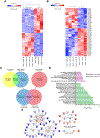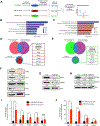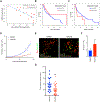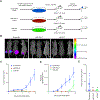TAp63-Regulated miRNAs Suppress Cutaneous Squamous Cell Carcinoma through Inhibition of a Network of Cell-Cycle Genes
- PMID: 32156775
- PMCID: PMC7299759
- DOI: 10.1158/0008-5472.CAN-19-1892
TAp63-Regulated miRNAs Suppress Cutaneous Squamous Cell Carcinoma through Inhibition of a Network of Cell-Cycle Genes
Abstract
TAp63 is a p53 family member and potent tumor and metastasis suppressor. Here, we show that TAp63-/- mice exhibit an increased susceptibility to ultraviolet radiation-induced cutaneous squamous cell carcinoma (cuSCC). A human-to-mouse comparison of cuSCC tumors identified miR-30c-2* and miR-497 as underexpressed in TAp63-deficient cuSCC. Reintroduction of these miRNAs significantly inhibited the growth of cuSCC cell lines and tumors. Proteomic profiling of cells expressing either miRNA showed downregulation of cell-cycle progression and mitosis-associated proteins. A mouse to human and cross-platform comparison of RNA-sequencing and proteomics data identified a 7-gene signature, including AURKA, KIF18B, PKMYT1, and ORC1, which were overexpressed in cuSCC. Knockdown of these factors in cuSCC cell lines suppressed tumor cell proliferation and induced apoptosis. In addition, selective inhibition of AURKA suppressed cuSCC cell proliferation, induced apoptosis, and showed antitumor effects in vivo. Finally, treatment with miR-30c-2* or miR-497 miRNA mimics was highly effective in suppressing cuSCC growth in vivo. Our data establish TAp63 as an essential regulator of novel miRNAs that can be therapeutically targeted for potent suppression of cuSCC. SIGNIFICANCE: This study provides preclinical evidence for the use of miR-30c-2*/miR-497 delivery and AURKA inhibition in the treatment of cuSCC, which currently has no FDA-approved targeted therapies.See related commentary by Parrales and Iwakuma, p. 2439.
©2020 American Association for Cancer Research.
Conflict of interest statement
Conflict of interest: The authors have declared that no conflict of interest exists.
Figures







Comment in
-
TAp63-miRNA-AURKA Axis as a Therapeutic Target for Cutaneous Squamous Cell Carcinoma.Cancer Res. 2020 Jun 15;80(12):2439-2440. doi: 10.1158/0008-5472.CAN-20-1215. Cancer Res. 2020. PMID: 32540854 Free PMC article.
Comment on
-
TAp63-miRNA-AURKA Axis as a Therapeutic Target for Cutaneous Squamous Cell Carcinoma.Cancer Res. 2020 Jun 15;80(12):2439-2440. doi: 10.1158/0008-5472.CAN-20-1215. Cancer Res. 2020. PMID: 32540854 Free PMC article.
Similar articles
-
TAp63-miRNA-AURKA Axis as a Therapeutic Target for Cutaneous Squamous Cell Carcinoma.Cancer Res. 2020 Jun 15;80(12):2439-2440. doi: 10.1158/0008-5472.CAN-20-1215. Cancer Res. 2020. PMID: 32540854 Free PMC article.
-
Cross-species identification of genomic drivers of squamous cell carcinoma development across preneoplastic intermediates.Nat Commun. 2016 Aug 30;7:12601. doi: 10.1038/ncomms12601. Nat Commun. 2016. PMID: 27574101 Free PMC article.
-
MicroRNA-124-3p affects proliferation, migration and apoptosis of bladder cancer cells through targeting AURKA.Cancer Biomark. 2017;19(1):93-101. doi: 10.3233/CBM-160427. Cancer Biomark. 2017. PMID: 28269755
-
miR-137 suppresses tumor growth of malignant melanoma by targeting aurora kinase A.Biochem Biophys Res Commun. 2016 Jul 1;475(3):251-6. doi: 10.1016/j.bbrc.2016.05.090. Epub 2016 May 24. Biochem Biophys Res Commun. 2016. PMID: 27233613
-
Integrative transcriptomic analysis for linking acute stress responses to squamous cell carcinoma development.Sci Rep. 2020 Oct 14;10(1):17209. doi: 10.1038/s41598-020-74051-7. Sci Rep. 2020. PMID: 33057049 Free PMC article.
Cited by
-
KIF18B: an important role in signaling pathways and a potential resistant target in tumor development.Discov Oncol. 2024 Sep 11;15(1):430. doi: 10.1007/s12672-024-01330-4. Discov Oncol. 2024. PMID: 39259333 Free PMC article. Review.
-
Role of non‑coding RNAs in UV‑induced radiation effects (Review).Exp Ther Med. 2024 Apr 23;27(6):262. doi: 10.3892/etm.2024.12550. eCollection 2024 Jun. Exp Ther Med. 2024. PMID: 38756908 Free PMC article. Review.
-
WDR82-Mediated H3K4me3 Is Associated with Tumor Proliferation and Therapeutic Efficacy in Pediatric High-Grade Gliomas.Cancers (Basel). 2023 Jun 30;15(13):3429. doi: 10.3390/cancers15133429. Cancers (Basel). 2023. PMID: 37444539 Free PMC article.
-
Target gene regulatory network of miR-497 in angiosarcoma.bioRxiv [Preprint]. 2023 Sep 25:2023.09.24.559218. doi: 10.1101/2023.09.24.559218. bioRxiv. 2023. Update in: Mol Cancer Res. 2024 Sep 4;22(9):879-890. doi: 10.1158/1541-7786.MCR-23-1075. PMID: 37808715 Free PMC article. Updated. Preprint.
-
Investigating Cutaneous Squamous Cell Carcinoma in vitro and in vivo: Novel 3D Tools and Animal Models.Front Med (Lausanne). 2022 May 9;9:875517. doi: 10.3389/fmed.2022.875517. eCollection 2022. Front Med (Lausanne). 2022. PMID: 35646967 Free PMC article. Review.
References
-
- Rogers HW, Weinstock MA, Harris AR, Hinckley MR, Feldman SR, Fleischer AB, et al. Incidence estimate of nonmelanoma skin cancer in the United States, 2006. Archives of dermatology 2010;146:283–7 - PubMed
Publication types
MeSH terms
Substances
Grants and funding
LinkOut - more resources
Full Text Sources
Medical
Molecular Biology Databases
Research Materials
Miscellaneous

